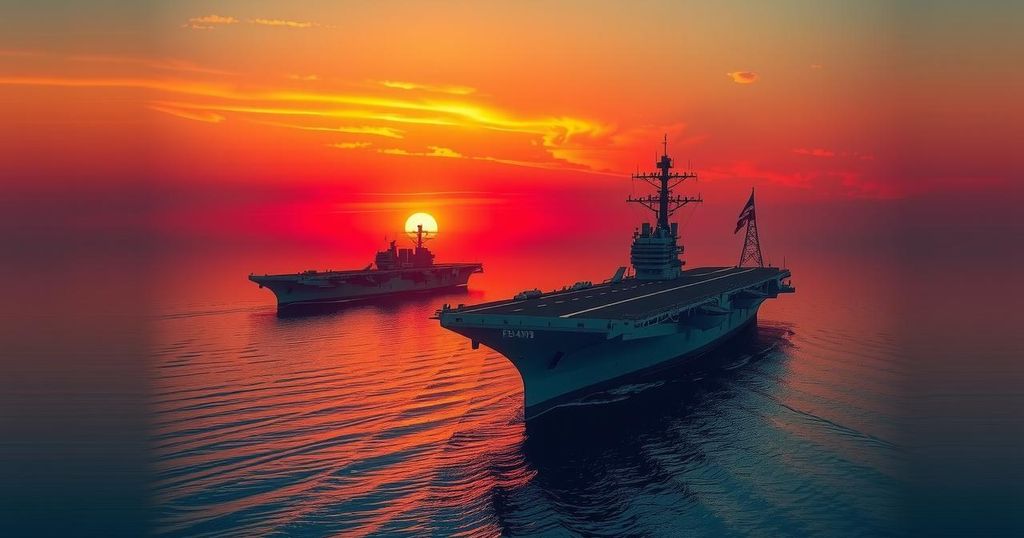Global news
AFRICA, ASIA, BIDEN, CARL VINSON, CENTRAL COMMAND, COMMAND, CONFLICT, DONALD TRUMP, DRONE STRIKES, GULF OF ADEN, HEGSETH, MARITIME SECURITY, MIDDLE EAST, MILITARY, NORFOLK, NORTH AMERICA, PETE HEGSETH, RED SEA, RETALIATION, SOUTH AFRICA, TRUMAN, U. S, U. S. CENTRAL COMMAND, UNITED STATES, VIRGINIA, WASHINGTON, YEMEN
Isaac Bennett
0 Comments
Hegseth Extends USS Truman’s Deployment Against Yemen’s Houthis
Defense Secretary Pete Hegseth has ordered the USS Harry S. Truman aircraft carrier to remain in the Middle East for an additional week to combat Yemen’s Houthi forces. This decision follows increased military operations and a recent spike in attacks on shipping in the Red Sea. Hegseth is also directing a new national defense strategy to be completed by August.
Defense Secretary Pete Hegseth has made a significant decision regarding U.S. military presence in the Middle East. He has ordered the USS Harry S. Truman aircraft carrier to extend its deployment for a second week, as part of efforts to maintain two carrier strike groups in the region. This move targets the Yemen-based Houthi terrorists, indicating an intensified focus on countering their activities.
In late March, the Truman’s deployment was initially extended for a month, reflecting a strategic approach to ramp up strikes against the Iran-backed Houthis. According to sources, Hegseth signed this latest order on Thursday, intending for the USS Truman and its accompanying warships to return to Norfolk, Virginia, after their extended mission concludes next week.
General Erik Kurilla, who leads U.S. Central Command, is said to have requested the Truman’s continued presence in the area. Currently, the USS Carl Vinson aircraft carrier and its strike group, which are based in San Diego, have joined operations in the Gulf of Aden. Meanwhile, the Truman, with its attached destroyers and a cruiser, are positioned in the Red Sea.
U.S. military operations against the Houthis have ramped up, with daily strikes ongoing since March 15. This escalation followed President Donald Trump’s directive to use “overwhelming lethal force” to deter Houthi attacks on shipping routes in the Red Sea, a critical trade artery for global commerce.
Officials indicate that the U.S. is conducting an “intense and sustained campaign” against the Houthi forces, having launched more than 1,000 strikes since the beginning of Operation Rough Rider. If there are no further extensions, sailors aboard the Truman and its warships could return home by next month.
Notably, this follows a previous directive from the Biden administration, which had tasked the USS Dwight D. Eisenhower to remain in the Red Sea for an extended period, marking the most intense maritime conflict since World War II.
The Houthis have persistently engaged in missile and drone offensives against various vessels, framing these actions as a response to ongoing conflicts, particularly the situation involving Hamas in the Gaza Strip. From November 2023 to January, the Houthis targeted over 100 merchant vessels, resulting in two sunk ships and fatalities among sailors, ultimately disrupting trade through this significant corridor that typically handles $1 trillion in goods annually.
After a period of self-imposed ceasefire, the group resumed their attacks upon the launching of broader U.S. military operations against them.
In addition to military strategies, Hegseth is prioritizing a new national defense strategy. He directed the Defense Department to draft this strategy, which is to be completed by August. This document will outline military priorities for addressing national security challenges and is anticipated to reflect Hegseth’s approach to personnel reforms and streamlining military commands in alignment with Trump’s “America First” policy.
In summary, Defense Secretary Pete Hegseth’s decision to extend the USS Harry S. Truman’s deployment underscores an intensified military response to the Houthi threat in the Middle East. With ongoing attacks as a backdrop, the U.S. military strategizes to bolster security in vital shipping lanes while Hegseth develops a new defense strategy to guide future priorities. This complex situation reflects the ongoing challenges faced by U.S. military operations and regional stability.
Original Source: www.reviewjournal.com




Post Comment